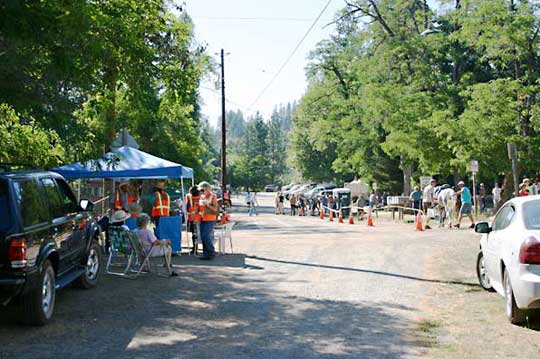
Michigan Bluff had everything...wealth, hardships, commerce, color, flavor...everything, except for a going concern.
Thousands of prospectors flooded into California from 1849 to 1852. Explorations for easier and better routes to the goldfields lead the prospectors to push new trails and wagon roads through the Sierra Nevada. After the "placers" (pure gold nuggets) along the rivers and streams were panned out, the miners moved up the canyons and began drift and hydraulic mining.
Settlements of varied sizes developed in the major mining areas. These communities of tents were built overnight. If the mines in the area were rich, a more permanent settlement with wood buildings was built. But if the mines were poor, the miners literally "pulled up stakes" and moved on. Most of the mining towns were located in remote, mountainous terrain along the canyons of the foothills of the Sierra Nevada. The hundreds of mining communities were connected by a web of trails and wagon roads up and down the steep canyons.
High upon the brow of the Middle Fork and El Dorado Canyons, some two thousand feet above their respective rivers, clinging to its steep slopes is a quiet little ghost town with its great days behind it, Michigan Bluff. At one time its mines shipped out $100,000.00 in gold each month.
Blasting, washing, and sluicing for gold had devastating effect, as the face of the countryside changed. What might have taken centuries to accomplish by natural erosion was produced in a very few years. Soil to a depth of 150 feet was washed from acres of land, using high-pressure water, leaving only bedrock exposed. Slopes stripped of trees and chaparral then became subject to accelerated erosion and landslides. The miners, as they continued to wash the ancient river channel, found their city above on the canyon edge beginning to move. Michigan City began to settle and slip, threatening to precipitate the town into the abyss. In 1859 the city was moved to its present site.
Between 1849 and 1850, mining camps located along the present-day Foresthill Divide were difficult to reach by foot, or by wagon. By 1851, the business communities of Michigan City (later Michigan Bluff), Deadwood, and Last Chance, were doing well, and the population was increasing, as was gold production. Many of the camps such as Deadwood and Last Chance could only be reached by foot, pack trains, or by horseback along a precipitous trail. Millions of dollars in value and several tons in weight of gold were packed out by mule trains over many years along the Michigan Bluff to Last Chance trail.
The Michigan Bluff to Last Chance section of the Western States Trail was built in 1850 and later became a maintained toll-trail, perhaps one of only a few toll-trails in the state. Toll price for people walking the trail was 25 cents.
While stages and mail service operated along the newly established roads, perhaps, of more importance were the freighters who supplied the camps with foodstuffs, clothing, mining tools, medicine, and many other supplies. During the early 1850's most camps were dependent upon the local freight companies, particularly during the winter months, when access in and out of the camps was more difficult. Supplies were brought in by large pack-trains of mules, rather than by wagons.
Next: Foresthill Vet Check






